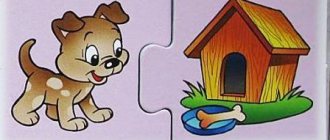Speech development in preschoolers
In order to successfully exist in society, a person needs the most important skill - the ability to communicate with other people. When communicating, a person conveys some of the information to the interlocutor using gestures and facial expressions. But the lion's share of it falls on that unique skill that is available on earth only to man. This skill is speech. Normal development of children certainly includes the acquisition of coherent speech. It is not an innate skill for people, and the child will have to master it on his own. Formed and continuously changing over many generations, speech is one of the most important components of human life. A small child faces a big, important task - to master the art of expressing his thoughts correctly and clearly, to assimilate all the richness and diversity of the Russian language. And the child, as a rule, successfully copes with its implementation.
The basics of using speech and its development occur in early childhood. That is, in the period from one year to 5-6 years, the basis is laid on which the child will subsequently build his entire life in society. Speech development is a unique phenomenon, directly related to both the intellectual development of the child and his communication skills. And, of course, during this period, a little person needs the help and support of loved ones more than ever; he needs someone who can guide his development and help him master rich and varied language material, teach him how to properly handle an amazing and complex instrument of communication - speech.
The development of coherent speech in a small person is a long and complex process. The relevance of this task for a preschool child is difficult to overestimate. With the help of speech, the child learns about the world around him, develops communication skills and associative thinking. From a scientific point of view, this process and its patterns are even studied by a separate linguistic discipline - ontolinguistics.
The child draws his first experience of reproducing human speech from his immediate environment, listening and remembering the speech of adults that he hears around him. Peculiarities of child psychology suggest imitative behavior as one of the main ones for a young child. Psychologists and sociologists have found that children who spend the first few years of life in social isolation subsequently cannot fully adapt to either language or life in society. This fact has been proven in the example of so-called wild children - children who, for some reason, were deprived of contact with people under the age of 6 years. Stories about such children repeating the fate of the hero of Kipling's fairy tale, Mowgli, periodically find documentary evidence. Only, unlike Mowgli, a child who finds himself isolated from human society at an early age cannot adapt to normal life. Such children have difficulty mastering the basics of human speech and suffer from serious developmental delays.
From this we can conclude that the early period of speech development is one of the most important in the overall development of a child, and parents should pay the closest attention to this process. Speech acquisition is a key indicator for preschool children of their overall mental development.
A child’s speech acquisition in preschool age can be divided into three stages, each of which has its own characteristics. They are closely related to both age and the general psychoneurological development of the baby.
Period up to a year
At this age, the baby is just beginning to distinguish for himself the speech of the adults around him. From the first month of life, the baby carefully peers and listens to everything that happens around him. He very quickly learns to distinguish between voices and intonations. Therefore, try to speak kindly to your baby more often, and comment out loud on your and his actions. Poems and songs are perfect for children at an early age.
If you, being next to your child, constantly contact him, talk, play, show objects and toys, then soon, already at 3-4 months, your baby will begin to engage in conversation with you, greeting you with a joyful roar.
By six months, the child gradually begins to babble, trying to pronounce syllables. At 7 months he already knows his name and turns his head when you call him by name. You can start playing “Ladushki”, “Magpie-Crow” or “The Horned Goat is Coming” with him. These nursery rhyme games will help your child better perceive rhythmically organized poetic speech, and they will simply bring a lot of joy. Try it - you'll see, the child will be delighted!
At 9-10 months, the baby can already laugh and tries to pronounce the first words, for example, “dad” or “mom”. Sing along to the music you hear. Understands the words “no”, “no”, can respond to greetings (waving a hand when saying “hello” or “bye-bye”). Your child’s vocabulary gradually begins to form, and is constantly replenished from the outside with new concepts and expressions. Poems, nursery rhymes, bedtime stories and just constant conversations with your baby will serve as an excellent incentive for him to start speaking on his own.
Initial speech acquisition
This stage of speech development occurs between the ages of approximately one and three years and has its own characteristics.
It must be borne in mind that before the child begins to master active speech and speak himself, he learns to understand the speech of others. Until about one and a half years old, only a few basic definition words can be observed in a child’s vocabulary: mom, dad, aunt, uncle, give. His family members still serve as role models for him, so don’t forget to continue telling your child what you are doing and why. He really already understands everything.
At this age, young children are prone to generalizations. Thus, "Yum!" can mean not only the feeding process, but also a child’s plate, spoon, and even a feeling of hunger. Also, in many words they discard the endings, ignore some letters (pronouncing “Aya” instead of “Anya”, etc.), and sometimes even shorten the word to one stressed syllable. There is no need to worry about these “irregularities” - they are completely normal. Over time, the child will learn to pronounce words and sounds correctly, and the family’s task is to unobtrusively explain to him how to do it correctly.
Try to articulate more clearly when talking to your baby. Give him the opportunity to watch your facial expressions when you say a new word. Show and name objects that come into your baby’s field of vision, especially while walking: a car, a dog or a crow flying past will not only entertain the child on the street, but will also help in the difficult task of developing speech.
In the second year of life, children distinguish intonation perfectly. Therefore, when reading fairy tales to your child, pay attention to the fact that a wolf or a bear, for example, speaks in a deep voice, and a little mouse squeaks in a thin voice.
After two and a half years, the child can already use simple sentences consisting of two or three words in coherent speech. In his mind, patterns begin to form in the agreement of words with each other, the difference between singular and plural. Language material acquires the features of a certain system in the child’s perception. And he begins to actively use this system, entering the next stage of speech acquisition.
Word creation
Speech development in preschool children goes through another interesting stage. At the age of about three years or a little older, the child moves from the accumulation of language material to its active development. To do this, he tries to use the patterns of language that he has managed to trace for himself at the moment. The famous children's writer Korney Ivanovich Chukovsky has a completely adult book, “From Two to Five.” Being a linguist, Korney Ivanovich in this work tried to determine what motivates small native speakers, every minute creating new words of their special children's dialect. And what did it turn out to be? It turns out that children do not create these neologisms by chance, but by sorting parts of words by meaning, and compose them following the grammatical structure of the Russian language. Thus, crackers turn into “bites” due to the semantic correspondence with the verb “bite”, a fan turns into “twirler”, a shaggy dog with long hair is succinctly characterized as “shaggy”, and the bed rest prescribed by the doctor immediately becomes “bed rest”.
Every day, every hour, a child is bombarded with many unfamiliar words, forms, and meanings. Nevertheless, he easily navigates this diversity, classifying, distributing, altering, adapting to himself the entire vocabulary available to him. A child’s speech develops easily, with a minimum of stress on the part of a small native speaker, whose intuition in relation to his native language is simply amazing!
End of preschool: preparation for reading and writing
At this stage, the child continues to acquire grammatical norms. But now he strives not so much to create as to correspond to the coherent speech of adults, to make it as correct as possible. In the monologues of a five- to six-year-old child, complex and complex constructions and linking words begin to appear. The grammatical structure of speech is leveled.
At the same age, the child begins to master written speech. And if in the first years of life, letters and numbers were an impossible abstraction for a child, but now, thanks to the experience gained, he can already trace the relationship between the real world and written language. Since reading and writing are psychophysiological processes, their relationship with the general development of speech in preschool children is very high.
As a rule, children learn to read before they write. Speech development includes the perception of the sound composition of a word on paper; understanding the relationship between sounds and letters occurs more easily if the child has sufficiently developed attention, memory, and has the skill of systems thinking. Therefore, preparation for reading and writing includes not only the development of speech in preschool children, but also systematic thinking and imagination.
Main types of speech and their characteristics
Below are the main types of speech and their characteristics.
Primary type of speech
Psychology divides human speech activity into two categories: internal and external.
Internal
It is associated with the thinking process, is not formalized orally or in writing, and is not a means of communication. It is figurative, fragmentary, it involves only words that convey the essence of the thought, so the speed of transmission is fast.
Inner speech performs an important preparatory function before the actual voicing of thoughts; thanks to it, “outlines” of statements are compiled.
External
Associated with the process of communication: spoken, written or read. Subtypes of external speech are oral and written.
Written
Formatted using written characters in compliance with grammatical rules. A clear construction of phrases, a thoughtful presentation of thoughts, and coherence of the resulting text are required. Written speech includes both writing itself and reading.
Conversational (dialogue)
A type of oral speech in which a conversation is carried on by two people, using simple phrases and turns of phrase. Does not require detailed expressions and is easily understood by the interlocutor.
Monologue
Refers to oral form, pronounced by one person.
Example: speech by a lecturer, speaker.
A monologue is close to written speech, due to the lack of feedback from the interlocutor. Compliance with the same rules as when writing is required: consistent mental presentation, logic, and the ability to coherently convey information. A monologue is considered a more complex type of speech than dialogue; it involves contact with the audience and requires preparation.
Schematic explanation of speech structure.
Thus, answering the question “What type of speech is primary in the development of a child’s speech activity?”, we can definitely talk about the oral conversational form. It is genetically primary: first, the child masters dialogue (from infancy through interaction with adults). And only then does he learn to organize thoughts in a monologue and writing. To prove the thesis, one can cite the fact that there are still languages and dialects that function only through oral communication. Oral speech is natural in nature, written language is its derivative.
Interesting fact! A large group of people for whom the main form of communication is neither oral nor written speech is the deaf and mute, who do not have hearing or voice from birth, or who have lost them as a result of accidents. For them, the main type of information transfer remains kinetics - gestures, signs. Historically, kinetic speech is the primary type of communication that has existed since ancient times. But, of course, it is not worth comparing the communications of the deaf and dumb with the way of communication of primitive people. The speech of mutes is characterized by complexity and systematization of signs and concepts.
Development of a child’s speech forms in a preschool educational institution
Kindergarten is the place where the development of a child’s personality begins. The professional competence of teachers plays a huge role in this process. The development of coherent speech in the form of constructing dialogues and monologues, laying the prerequisites for writing is one of the primary tasks of a preschool educational institution.
Features of speech development in children of senior preschool age
It is important to understand! This is not a narrowly focused activity, but a whole range of measures taken by specialists, requiring creative solutions. A modern approach to working and teaching both children and teachers themselves is important.
To date, the Federal State Standard of Preschool Education (FSES DO) has been developed and introduced, which identifies the main areas of child development:
- Social and communicative development,
- Cognitive,
- Speech development,
- Artistic and aesthetic,
- Physical.
Educational field "Speech development" according to the Federal State Educational Standard for Education
This standard implies competent work by specialists to help children master the following areas:
- Free expression of thoughts and feelings to establish contact with other children and adults.
- Replenishment of vocabulary, the ability to combine words into sentences, change the form of words, i.e. mastering the grammatical structure.
- Development of creativity, the ability to compose short stories, think through the plots of fairy tales.
- Mastering the stress system, correct pronunciation of sounds, the ability to speak expressively and read poetry.
- Studying letters, word morphology, syntactic rules, preparing for literacy, mastering the basics of writing.
- Gaining experience in reading books.
What to do if the child does not speak?
The problem of speech disorders in preschoolers today is very relevant for parents, speech therapists and psychologists. If it seems to you that your child speaks worse than he should at his age, his speech is poor and incoherent, or the baby is in no hurry to speak at all, seek help from a specialist. He will help identify the cause of the disorder in the baby’s speech development and advise ways to solve this problem.
The following symptoms may indicate speech development disorders. Child aged 2-3 years:
- does not respond to his name;
- does not try to imitate sounds;
- does not respond to simple words and requests voiced using simple and frequently used words;
- does not respond to changes in intonation when you address him;
- He speaks little himself, trying to convey information through facial expressions and gestures.
Over the age of three years, parents should be alert to the following signs:
- the child cannot retell the content of a poem, a fairy tale, or explain what he drew or what happened in kindergarten;
- doesn't ask questions;
- cannot and does not want to play speech games, finish a word, describe something;
- does not speak in sentences longer than two or three words;
- speech is monotonous, inexpressive, strangers do not understand your child’s speech;
- cannot maintain attention on the same topic, is quickly distracted, and loses the thread of the conversation.
In all of the above cases, it would be better not to delay the visit to a specialist. A speech therapist will help you choose the necessary exercises for speech development. Remember: the sooner you start correcting speech development, the more successfully and with less stress on the child’s part you can correct the situation.
Speech developmental disorders
The causes of speech development disorders can be divided into three groups. The first group will include problems caused by biological factors. This is primarily a lesion of the central nervous system and anomalies in the structure of the speech apparatus. These include the following deviations in child development:
- Aphasia. Damage to the areas of the cerebral cortex responsible for speech function, resulting in damage to all components of speech.
- Alalia. Damage to the speech areas of the brain that occurs in the first year of a child’s life (pre-speech period), resulting in complex speech underdevelopment.
- Dysarthria. Disruption of the normal functioning of the muscles that provide speech, as a result of which the child cannot pronounce sounds normally. Dysarthria has several types, differing from each other by the focus of the lesion: bulbar, pseudobulbar, cerebellar, subcortical.
- Rhinolalia. Occurs in children whose structure of the palate is disturbed.
- Mechanical dyslalia. Violation of the structure of the nasopharynx, nose and mouth, leading to pronunciation defects.
The second group consists of speech disorders in preschoolers caused by psychological factors that lead to functional changes in the central nervous system. It can be:
- Stuttering. Disruption of the normal rhythm of speech due to involuntary stops that interrupt the utterance, or repetitions of syllables and sounds.
- Mutism. The child refuses to speak in the presence of strangers if he has a speech defect.
- Surdomutism. Hearing impairment leading to speech problems.
The third group includes speech development disorders provoked by certain unfavorable social conditions. If, for example, the parents do not communicate with the child, do not talk to him, then the baby simply has nowhere to get new language material from, and, of course, his speech will be poor and less coherent than the speech of a child whose need for full communication is satisfied in the family.
Methods for examining the speech of preschool children
Diagnosis of speech development in children of early and preschool age is carried out according to the following parameters:
- Child's dictionary.
- Sound culture of speech.
- Grammar.
- Development of coherent speech.
Used literature on the topic: Gribova O. E., Bessonova T. P. “Didactic material on examining children’s speech”
Specialists should evaluate a child's skills only using appropriate diagnostic materials that help them objectively approach the assessment of children's speech abilities. To select instruments and examination technologies, it is recommended to use the methodological literature of Gribov and Bessonov “Didactic material for examining children’s speech.”
It is presented in three directions:
- "Lexicon",
- "Grammar structure"
- “Sound Side” part 1, part 2.
Survey of the sound culture of children's speech
The concept of “sound side” refers to sound pronunciation. Diagnosis of the sound culture of speech of preschoolers should be carried out by a speech therapist twice a year: in the fall - when drawing up a plan for correctional work, and in the spring - when summing up the results.
Important! During the study of sound pronunciations, the teacher should note the following indicators: which sounds were pronounced correctly, whether there are violations of the syllabic structure of words, whether the child can regulate the strength of the voice, tempo, whether there were any omissions in sound pronunciation correction, active or passive speech activity.
Methods for developing coherent speech
There are several methods for developing coherent speech, they are described below.
Modern educational technologies
The development of coherent speech in preschool children means the improvement of dialogic and monologue speech forms. To do this, teachers must integrate the following technologies into their work:
- Game (speech exercises, communication exercises, games for fine motor skills, role-playing games, etc.).
- ICT.
- Mnemonics.
A complex of articulatory gymnastics in kindergarten for children 3-4 years old
Mnemonics as a technique for developing coherent speech in preschoolers
Mnemonics is a technique that makes it easier to memorize words by forming associations. In mnemonics, information that is difficult for a child to understand must be replaced with a visual image. This technique promotes the development of imagination, visual memory, and associative thinking.
Important! In the development of coherent speech in preschoolers, specialists are required to use mnemonic tables.
Analysis map of GCD for speech development in preschool educational institutions according to the Federal State Educational Standard
The key to the successful development of a child’s speech culture lies in the correct planning and conduct of direct educational activities (DEA). To do this, teachers should keep GCD analysis cards with a pre-drawn up work plan, taking into account the specifics of children’s speech problems, identifying methods for their correction, and drawing up explanatory recommendations for working with children, including for parents.




